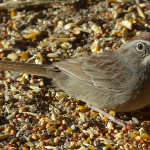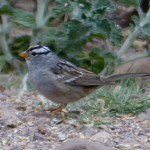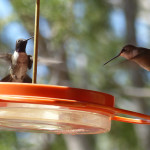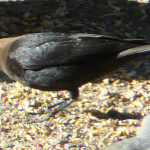Along Bear Creek, at the Edge of the Gila Wilderness
in Southwest New Mexico

THE GILA NATIONAL FOREST – EXTREME DIVERSITY IN BIRD HABITAT

The Gila National Forest is vast — comprising some 3.3 million acres — and pristine, with roughly one-quarter of its acreage officially classified as Wilderness, including the Gila, the Aldo Leopold, and the Blue Range Wildernesses. Within this area elevations range from 4,200 feet along the Gila River to 10,895 feet on Whitewater Baldy in the Mogollon Mountains. Within this 6,700 topographical range, the U.S. Forest Service in its excellent publication Birds of the Gila National Forest: A Checklist, recognizes 10 different major bird habitat zones, including Desert, Oak Woodland, Oak-Juniper, Pinyon-Juniper, Ponderosa Pine, Spruce Fir, Mountain Grassland, Open Marsh, Deciduous Riparian, and Coniferous Riparian. Because of this great diversity in habitat, the Gila National Forest is home to or visited by some 377 different species of birds.
Observable species of birds in the Gila National Forest varies dramatically with the seasons due to the fact that it is located on the Rocky Mountain leg of the Central North American Migration Flyway, one of the four Flyway Bird Migratory Systems that cross the United States and Canada in a north-south pattern.
BIRD HABITATS IN THE GILA NATIONAL FOREST ACCESSIBLE FROM CASITAS DE GILA GUESTHOUSES
All 10 of the different major bird habitat zones of the Gila National Forest listed above occur within a 25-mile radius of Casitas de Gila, and are easily accessed by day-trip excursions from the Casitas. Recently, a joint project of several State and Federal agencies, plus non-profit conservation groups, has resulted in the creation of the New Mexico Birding Trail, which identifies some 40 of the most attractive birding locations in Southwest New Mexico. Eighteen of these sites, Sites 14–31, are excellent day-trip destinations from the Casitas. Several of the best sites are found along the Gila River, just 5 to 10 miles from the Casitas, including Site 21, The Nature Conservancy’s Gila Riparian Preserve at the junction of Mogollon Creek and the Gila River; Site 20, the Billings Vista Birding Area; and Bill Evans Lake. An interesting article describing a few more of these birding sites within the Gila National Forest can be found in the June 2003 issue of Winging It, the Newsletter of the American Birding Association.
BIRD HABITAT AND DIVERSITY AT CASITAS DE GILA
The landscape comprising the 265 acres on which guesthouses of Casitas de Gila are situated offers a unique combination of bird habitat and species diversity for the birding enthusiast. Three of the 10 bird habitat zones are represented here, including the Deciduous Riparian along the bottom of Bear Creek Canyon, a narrow zone of Oak-Juniper bordering the Riparian zone, and an expansive zone of Pinyon-Juniper that extends away from the Canyon into the adjacent surrounding hills and low mountains. As the guesthouses are situated on cliffs at the very edge of Bear Creek Canyon overlooking Bear Creek a hundred feet below and the slopes of the mountainous terrain rising from the creek on the opposite side, all three habitats and accompanying species diversity can be observed right from the front porch of each Casita! For 15 years the Casitas have maintained a year-round feeding program that keeps the resident species close at hand and brings the migratory species back year after year. From April through September hummingbird feeders are hung on the porch of each Casita, and a supply of necter is available to keep them refilled.
SOME TYPICAL WINTER BIRDS AND HABITAT AT CASITAS DE GILA
Winter along Bear Creek at Casitas de Gila is generally mild with overnight lows in the high teens to 20s F, and daytime highs in the 40s to 50s F. Precipitation from the occasional low pressure fronts moving through generally starts out as rain and then turns to light snow as the system passes by. Typically, at 4,800 feet, the Casitas will only receive 2 to 4 light snowfalls during the Winter, with accumulations of 2 to 3 inches, which generally melt away within 24 hours. To the north in the higher elevations of the Gila Wilderness, snow accumulations are heavier and will last for weeks, particularly on north-facing slopes. Consequently, the landscape around the Casitas and the adjacent Gila River Valley is bare 95% of the Winter, providing the birding enthusiast with excellent opportunities for hiking and observing the numerous species of birds that make this area their home during the Winter months.


These photos of Winter Birds were all taken at Casitas de Gila Guesthouses (click on photo for full-size image):















SOME TYPICAL EARLY SPRING BIRDS AND HABITAT AT CASITAS DE GILA
By the third week in March, Spring is very much in the air at Casitas de Gila. The Cottonwoods and Willows are showing green buds and various grasses and plants along the Creek are beginning to put out green shoots. Daytime temperatures are in the low 60s and the nights are in the low 30s to 40s. By the last week of April, it has warmed up with daytime temperatures in the high 60s and into the 70s. By this time, Bear Creek Canyon below the Casitas is once more a ribbon of green, with the Cottonwoods and Willows well leafed out, and the Mesquite on the hillsides are putting out leaves as well. While it is still possible for a late frost, this year it doesn’t happen, once more confirming the local conventional wisdom that the Mesquite always waits until the frosts are over before leafing out.


By the last week in March, the annual Spring Migration is starting. While most of the birds of Winter are still dominant in numbers, new faces appear daily at the Casita bird feeders. And most colorful and varied these newcomers are! Depending on the year, within a few days either side of April 1, the first telltale zoom-zoom of the hummingbird, generally the Black-chinned, is heard announcing their arrival. And embedded in the the zoom-zoom is the not-so-subtle demand “Where are the feeders, where are feeders! We’re starved!” And so, up go the feeders at each Casita, which will consume untold gallons of sugar water on a daily basis between April and October when they are purposely taken down, sending a message to those ravenous little travelers that it’s high time to head South!
The Gila National Forest Bird Checklist lists seven species of hummingbirds that can be found in the forest: Blue-throated, Magnificent, Black-chinned, Anna’s, Calliope, Broad-tailed, and Rufous. Here at Casitas de Gila Guesthouses we will generally see five of the seven over the course of the Spring and Summer months. In order of abundance they would be: the Black-chinned and the Broad-tailed which are here all season, the Rufous which arrives in late July, with occasional visits by the Calliope and the Magnificent. By July and August the hummers are at their peak here, when literally swarms of them will be at the feeders from the first light of day until dusk. Since the feeders at each of the Casitas are under the porch just outside the bedroom window, most guests find it quite a unique experience to be awakened by the whirring drone of numerous little wings beating at 50 to 100 times per second as the hummers begin their day-long siege on the feeders.
These photos of Early Spring Birds were all taken at Casitas de Gila Guesthouses (click on photo for full-size image):









House Finch



